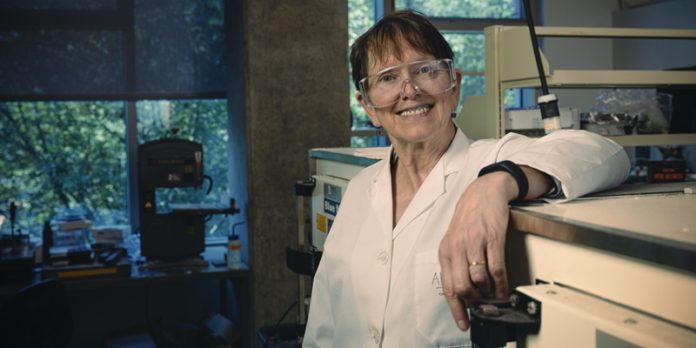Find Info For
Quick Links
November 9, 2022
Thousands, if not millions, of solder joints exist in a single circuit board. Carol Handwerker, the Reinhardt Schuhmann Jr. Professor of Materials Engineering at Purdue, is leading research to determine when lead-free solders might be more reliable for defense systems than tin-lead solder. (Purdue University photo/Charles Jischke)
WEST LAFAYETTE, Ind. – Carol Handwerker’s life’s work is aimed at increasing reliability in everything from the largest Navy carrier to the family car. She does it by researching probably the most inconspicuous material: solder.
Handwerker, the Reinhardt Schuhmann Jr. Professor of Materials Engineering at Purdue University, has tested and researched materials for almost 30 years to determine the best options for solder that connects electronic components to circuit boards, focusing on almost any physical condition that a circuit board could encounter.
In today’s evolving era of microelectronics, green polymer circuit boards are among the most important factors. Without these functioning circuit boards – that can range from the size of a fist to a large photo frame – even a lot of the cars on the road today would stay parked.
“In today’s boards, there are so many interconnects,” Handwerker said. “There are thousands, if not millions, of solder joints in a single circuit board. If a solder joint fails, the system is compromised. So, it’s important that solder is reliable.”
Tin-lead solder was the mainstay for more than 50 years. But environmental and health concerns brought about the evolution of a new generation of solders that are lead-free and use alloys that are a better, nontoxic alternative to tin-lead.
One of more than 60 kinds of solder on the market today, tin-lead solder was banned by the European Union in 1999 for use in consumer electronics because of toxicity concerns. Handwerker, also a professor of environmental and ecological engineering at Purdue, was part of four years of research in the 1990s that preceded that ban, setting a baseline for possible replacement alloys. She worked closely with industry in the 2000s to transition to the new standard lead-free alloy for consumer electronics worldwide.
The only industries still exempted by the EU are defense, aerospace and implantable medical devices.
Handwerker’s current research is part of the U.S. Partnership for Assured Electronics (USPAE) and is backed by a $40 million U.S. Department of Defense contract. The work is in concert with defense companies and experts from the University of Maryland, Auburn University and Binghamton University and focuses on determining when lead-free solders might be as reliable or more so than tin-lead when used in defense systems.
“We’re providing options in a way that gives all of us confidence in our solder choices,” Handwerker said. “Solder is used in Department of Defense systems everywhere there are circuit boards, from handheld communication devices and battleships to helicopters and missiles. We are working to quantify how different lead-free solders behave in various highly demanding environments compared with tin-lead.”
Now in its second year, the five-year project has developed the first edition of the Solder User’s Handbook, which was recently approved by the Department of Defense. Handwerker said the project also is developing specifications and underlying scientific analysis allowing researchers to extrapolate to more extreme defense environments.
Handwerker is joined in her solder project by three other Purdue professors – Ganesh Subbarayan, professor of mechanical engineering; John Blendell, professor of materials engineering; and Nikhilesh Chawla, the Ransburg Professor of Materials Engineering – and Harvey Abramowitz, a professor of mechanical engineering at Purdue University Northwest.
As the inconspicuous glue that holds the components of circuit boards together, solder has a litany of microelectronics uses in Department of Defense vehicles and equipment. Jets face thermal cycling issues in which systems must function through high heat, then cold temperatures and back to high heat. Vibration and shock impact scenarios are shared by the solder used in circuit boards for planes, naval vessels and missiles.
Current experimentation at Purdue is focused on data analysis, solder reliability testing and process testing that confirms what the melting temperatures are for the solders. An in-depth testing plan is being developed.
Purdue is a national leader in microelectronics devices and packaging research, spanning the semiconductor ecosystem in software and hardware.
Purdue already has established excellence in key research areas considered critical to national security, including microelectronics. The area is among the critical topics under Purdue’s Next Moves, strategic initiatives that will advance the university’s competitive advantage.
A recent agreement with MediaTek, a leading global chipmaker, partnerships for future workforce development and the establishment of a semiconductor degrees program are the latest pieces of Purdue’s continually expanding research and development efforts in the field of microelectronics and semiconductors.
Here is more on Purdue’s leadership in the area of microelectronics.
About Purdue University
Purdue University is a top public research institution developing practical solutions to today’s toughest challenges. Ranked in each of the last five years as one of the 10 Most Innovative universities in the United States by U.S. News & World Report, Purdue delivers world-changing research and out-of-this-world discovery. Committed to hands-on and online, real-world learning, Purdue offers a transformative education to all. Committed to affordability and accessibility, Purdue has frozen tuition and most fees at 2012-13 levels, enabling more students than ever to graduate debt-free. See how Purdue never stops in the persistent pursuit of the next giant leap at https://stories.purdue.edu.
Writer/Media contact: Brian Huchel, [email protected]
Source: Carol Handwerker, [email protected]
Purdue University, 610 Purdue Mall, West Lafayette, IN 47907, (765) 494-4600
© 2015-22 Purdue University | An equal access/equal opportunity university | Copyright Complaints | Maintained by Office of Strategic Communications
Trouble with this page? Disability-related accessibility issue? Please contact News Service at [email protected].






